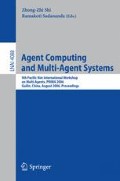Abstract
Intentions, a crucial part of the mental state of an agent, play an important role in determining the behavior of rational agents. In order to eliminate the flaws with existing logic of intention, in this paper, we address the requests for intention semantics on formal frameworks of rational agents and the problems with existing logic of intention, put forward a novel semantics for intention, called the multi-subset possible world semantics, and its application in the formalization of intention for agent. The multi-subset possible world semantics use three subsets to describe intention. It not only avoids the logical omniscience problem and other related problems (such as side-effect problem, and etc) but also overcomes the shortcomings of the true-false subset semantics and twin-subset semantics. Compared with Konolige and Pollack’s model of intention, this semantics model doesn’t lose the reasoning ability of non-equivalent intention, and what’s more, it is simpler, more natural and satisfies the K axiom and the Joint Consistency. Our framework invalidates the problematic properties with existing logic of intention. And by imposing certain constraints on the algebraic structure of the models, many desirable properties can be obtained. At last we make an analysis for the multi-subset possible world semantics. Actually the multi-subset possible world semantics provides a new method for semantic representation of non-normal modal operators. It can be used in establishing new proper agent’s logic systems.
Access this chapter
Tax calculation will be finalised at checkout
Purchases are for personal use only
Preview
Unable to display preview. Download preview PDF.
References
Bratman, M.E.: Intentions, Plans and Practical Reason. Harvard University Press, Cambridge, MA (1987)
Cohen, P.R., Levesque, H.J.: Intention is Choice with Commitment. Artificial Intelligence 42(2-3), 213–261 (1990)
Konolige, K., Pollack, M.E.: A Representationalist Theory of Intention. In: Bajcsy, R. (ed.) Proceedings of the Thirteenth International Joint Conference on Artificial Intelligence, pp. 390–395. Morgan Kaufmann Publishers, San Mateo (1993)
Rao, A.S., Georgeff, M.P.: Modeling rational Agents within a BDI architecture. In: Allen, J., Fikes, R., Sandewall, E. (eds.) Principles of Knowledge Representation and Reasoning: Proceedings of the Second International Conference (KR-1991), pp. 473–484. Morgan Kaufmann Publishers, San Mateo (1991)
Rao, A.S., Georgeff, M.P.: The Semantics of Intention Maintenance for Rational Agents. In: Mellish, S.C. (ed.) Proceedings of the 14th International Joint Conference on Artificial Intelligence, pp. 704–710. Morgan Kaufmann Publishers, San Mateo (1995)
Cavedon, L., Padgham, L., Rao, A., et al.: Revisiting rationality for agents with intentions. In: Yaoed, X. (ed.) Proceedings of the 8th Australian Joint Conference on Artificial Intelligence, pp. 131–138. World Scientific Publishing Co. Pet. Ltd, Singapore (1995)
Rao, A.S., Georgeff, M.P.: Asymmetry thesis and side-effect Problems in linear- time and branching-time intention logic. In: Proceedings of the 12th International Joint Conference on Artificial Intelligence, pp. 498–504. Morgan Kaufmann Publishers, Inc, San Mateo, CA (1991)
Shan-Li, H., Chun-Yi, S.: Agent Logic and The True-false Subset Semantics. Journal of Software (in Chinese) 13(11), 2112–2115 (2002)
Shan-Li, H., Chun-Yi, S.: Twin-Subset Semantic Model for Intention. In: On the Proceedings of the Second International Conference on Machine Learning and Cybernetics, IEEE, vol. 4, pp. 2004–2008 (2003.11)
Shan-Li, H., Chun-Yi, S.: An Improved Twin-Subset Semantic Model for Intention of Agent. Journal of Software (in Chinese) 17(3), 396–402 (2006)
Author information
Authors and Affiliations
Editor information
Editors and Affiliations
Rights and permissions
Copyright information
© 2006 Springer-Verlag Berlin Heidelberg
About this paper
Cite this paper
Hu, SL., Shi, CY. (2006). A Multi-subset Possible World Semantics for Intention Operator of Agent. In: Shi, ZZ., Sadananda, R. (eds) Agent Computing and Multi-Agent Systems. PRIMA 2006. Lecture Notes in Computer Science(), vol 4088. Springer, Berlin, Heidelberg. https://doi.org/10.1007/11802372_47
Download citation
DOI: https://doi.org/10.1007/11802372_47
Publisher Name: Springer, Berlin, Heidelberg
Print ISBN: 978-3-540-36707-9
Online ISBN: 978-3-540-36860-1
eBook Packages: Computer ScienceComputer Science (R0)

